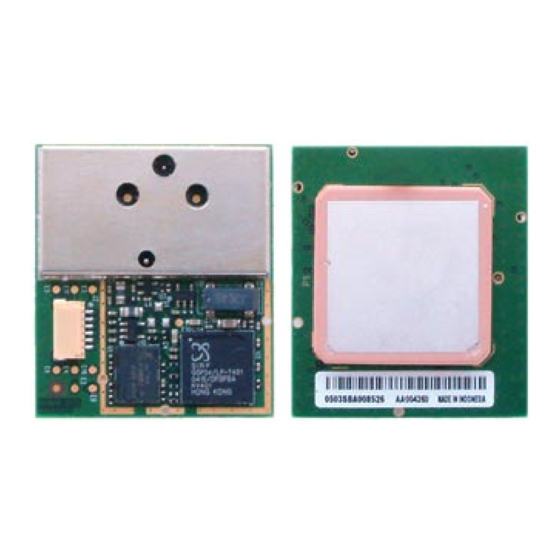
Table of Contents
Advertisement
Quick Links
Arrow.com.
Downloaded from
Jupiter 110
Integrated GPS Sensor
Module
Data Sheet/
Integrator's Manual
LA000504D © 2006 Navman New Zealand. All rights reserved. Proprietary information and specifications subject to change without notice.
Related documents
• Jupiter 110 Product brief LA000511
• Low Power Operating Modes application
note LA000513
• Navman NMEA reference manual
MN000315
• SiRF Binary protocol reference manual
Advertisement
Table of Contents

Subscribe to Our Youtube Channel
Summary of Contents for Navman Jupiter 110
-
Page 1: Related Documents
• Low Power Operating Modes application note LA000513 • Navman NMEA reference manual MN000315 • SiRF Binary protocol reference manual LA000504D © 2006 Navman New Zealand. All rights reserved. Proprietary information and specifications subject to change without notice. Arrow.com. Downloaded from... -
Page 2: Table Of Contents
6.2.2 Low power acquisition configuration ..............13 6.3 Navman NMEA active antenna status message ............13 6.4 SiRF binary output ......................13 LA000504D © 2006 Navman New Zealand. All rights reserved. Proprietary information and specifications subject to change without notice. Arrow.com. Arrow.com. Downloaded from... - Page 3 Table 6-3: Low power acquisition input values ..............13 Table 6-4: Antenna status output message values ............13 Table 10-1: Jupiter 110 ordering information ..............16 LA000504D © 2006 Navman New Zealand. All rights reserved. Proprietary information and specifications subject to change without notice. Arrow.com. Arrow.com.
-
Page 4: Introduction
2.0 Technical description The Jupiter 110 module provides a 12-channel GPS receiver and patch antenna in an open board design that is compact, versatile and easy to adopt. The Jupiter 110 is available in four configurations: • Jupiter 110 (standard) – GSW2 navigation software •... -
Page 5: Major Components Of The Jupiter 110
2.4 Physical characteristics The Jupiter 110 is an open frame structure on a single PCB, with patch antenna mounted on the upper surface and the GPS receiver components housed on the lower surface. -
Page 6: Compliances
6 and 7: : product revision character 8 sequential serial number characters 9-13: LA000504D © 2006 Navman New Zealand. All rights reserved. Proprietary information and specifications subject to change without notice. Arrow.com. Arrow.com. Arrow.com. Arrow.com. Arrow.com. -
Page 7: Performance Characteristics
The battery backup input line powers the RTC section of the baseband receiver. Supplying power to this pin is required for normal operation and ensures that the RTC continues to operate even when the main power is interrupted. Refer to Table 4-1 for the Jupiter 110 battery backup supply voltages. -
Page 8: Differential Aiding Waas/Egnos
3.7 Core processor performance The standard Jupiter 110 with GSW2 software runs at a CPU clock speed of 12.28 MHz. Using XTrac software (Jupiter 110S and 110RS), the clock speed increases to 24.5 MHz. An SDK (Software Development Kit) is available from SiRF to customise the Jupiter 110 firmware. -
Page 9: Electrical Requirements
Table 4-3: RF sensitivity at external RF connector The external antenna input requires additional signal gain in the external antenna. Note: LA000504D © 2006 Navman New Zealand. All rights reserved. Proprietary information and specifications subject to change without notice. Arrow.com. Arrow.com. -
Page 10: Data Input/Output Levels
To reset the ‘over current’ trip, remove power from the unit for >3 s. Table 5-1: External antenna characteristics LA000504D © 2006 Navman New Zealand. All rights reserved. Proprietary information and specifications subject to change without notice. Arrow.com. Arrow.com. Arrow.com. -
Page 11: External I/O Connector
Refer to the JST website for further details (www.jst.com). A mating connector and cable assembly (Navman part number CB000222D can be supplied optionally by Navman. LA000504D © 2006 Navman New Zealand. All rights reserved. Proprietary information and specifications subject to change without notice. Arrow.com. Arrow.com. -
Page 12: Software Protocol
The following sections describe the software protocol, including the default NMEA-0183 (v2.2) protocol. 6.1 NMEA output The Jupiter 110 has a default data transmission speed of 9 600 Baud. The update rate is once per second. The configuration parameters set via the NMEA command sentences are stored in battery backed memory and will be used at power up. -
Page 13: Low Power Acquisition Configuration
Navman NMEA reference manual. For a full list of the SiRF binary commands, refer to the SiRF Binary Protocol reference manual. LA000504D © 2006 Navman New Zealand. All rights reserved. Proprietary information and specifications subject to change without notice. Arrow.com. -
Page 14: Mounting Option
LA000504D © 2006 Navman New Zealand. All rights reserved. Proprietary information and specifications subject to change without notice. Arrow.com. -
Page 15: Jupiter 110 Mechanical Layout
Unless otherwise stated all dimensions are in mm. Tolerances: 0 ± 0.2 – 0.0 ± 0.1 side view Figure 9-1: Jupiter 110 mechanical layout LA000504D © 2006 Navman New Zealand. All rights reserved. Proprietary information and specifications subject to change without notice. Arrow.com. Arrow.com. Arrow.com. -
Page 16: Ordering Information
The system of satellites and ground stations developed by the FAA (Federal Aviation Administration) that provides GPS signal corrections. WAAS satellite coverage is currently only available in North America. LA000504D © 2006 Navman New Zealand. All rights reserved. Proprietary information and specifications subject to change without notice. Arrow.com. Arrow.com. - Page 17 Navman products are not intended for use in medical, lifesaving or life sustaining applications. Navman customers using or selling Navman products for use in such applications do so at their own risk and agree to fully indemnify Navman for any damages resulting from such improper use or sale.

Need help?
Do you have a question about the Jupiter 110 and is the answer not in the manual?
Questions and answers